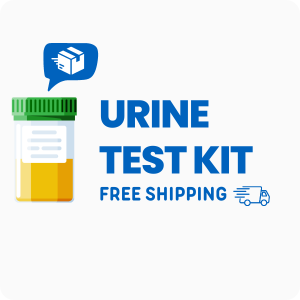MycoTOX Mold Exposure Lab Test by Great Plains (now MosaicDx)
Mold exposure can lead to long-term health issues such as heart disease, autoimmune conditions, asthma, depression, anxiety, and more. Mold may also play a role in undiagnosed “mystery” cases.
Mold releases toxic byproducts called mycotoxins into the air, which are then inhaled. These mycotoxins are eliminated through urine and can be tested for.
Mycotoxins are also released if you have a mold or fungal infection. Most infections occur in the lungs, gastrointestinal (GI) tract, or blood. Mycotoxin exposure is also linked to Chronic Inflammatory Response Syndrome (CIRS).
The MycoTOX test detects 11 different mycotoxins from 40 species of mold. It uses mass spectrometry, which can identify very low levels of mycotoxins, making it especially useful for follow-up testing to ensure successful treatment.
Labs Included in Your Order
| Test Name | Reference Range | Significance | High and Low Levels |
|---|---|---|---|
| Aflatoxin M1 (AFM1) |
|
AFM1 is a metabolite of aflatoxin B1, produced by Aspergillus molds, commonly found in contaminated food products. It is a potent carcinogen associated with liver cancer and other health issues. | High: High levels of Aflatoxin M1 indicate significant exposure to aflatoxins, increasing the risk of liver damage and cancer.
Low: Low levels of Aflatoxin M1 suggest minimal exposure, indicating a lower risk of related health issues. |
| Ochratoxin A (OTA) |
|
OTA is a mycotoxin produced by Aspergillus and Penicillium species, commonly found in water-damaged buildings and contaminated foods. It is nephrotoxic and has been linked to kidney disease and neurological effects. | High: High levels of Ochratoxin A suggest significant exposure, potentially leading to kidney damage and neurological issues.
Low: Low levels of Ochratoxin A indicate minimal exposure, reducing the risk of associated health problems. |
| Sterigmatocystin (STG) |
|
STG is a mycotoxin related to aflatoxin, produced by molds like Aspergillus and Penicillium. It is considered carcinogenic, particularly affecting the gastrointestinal tract and liver. | High: High levels of Sterigmatocystin indicate exposure, increasing the risk of liver and gastrointestinal cancers.
Low: Low levels of Sterigmatocystin suggest minimal exposure, indicating a lower risk of related health issues. |
| Roridin E |
|
Roridin E is a macrocyclic trichothecene mycotoxin produced by molds like Stachybotrys, commonly found in water-damaged buildings. It is highly toxic, inhibiting protein synthesis and causing severe health effects. | High: High levels of Roridin E suggest significant exposure, potentially leading to neurological damage and immunosuppression.
Low: Low levels of Roridin E indicate minimal exposure, reducing the risk of associated health problems. |
| Verrucarin A |
|
Verrucarin A is a macrocyclic trichothecene mycotoxin produced by molds such as Stachybotrys and Fusarium. It disrupts cellular functions, leading to immunological problems and gastrointestinal distress. | High: High levels of Verrucarin A indicate exposure, increasing the risk of immune suppression and digestive issues.
Low: Low levels of Verrucarin A suggest minimal exposure, indicating a lower risk of related health issues. |
| Enniatin B1 |
|
Enniatin B1 is a mycotoxin produced by Fusarium species, commonly contaminating cereals. It has antibiotic properties and can cause weight loss, fatigue, and liver disease upon chronic exposure. | High: High levels of Enniatin B1 suggest significant exposure, potentially leading to liver ::contentReference[oaicite:0]{index=0}damage and chronic fatigue.Low: Low levels of Enniatin B1 indicate minimal exposure, reducing the risk of associated health concerns. |
| Zearalenone (ZEA) |
|
ZEA is an estrogenic mycotoxin produced by Fusarium molds, often found in grains. It disrupts hormonal balance and reproductive health, especially in women and livestock. | High: High levels of Zearalenone indicate hormonal disruption, potentially leading to infertility and estrogen-related cancers.
Low: Low levels of Zearalenone suggest minimal exposure, indicating a lower risk of endocrine issues. |
| Gliotoxin |
|
Gliotoxin is a mycotoxin produced by Aspergillus and Candida species. It suppresses immune function and is associated with infections and chronic inflammation in immunocompromised individuals. | High: High levels of Gliotoxin suggest immune suppression and increased susceptibility to infections.
Low: Low levels of Gliotoxin indicate minimal exposure, reducing the risk of immune-related disorders. |
| Mycophenolic Acid |
|
Mycophenolic acid is a mycotoxin produced by Penicillium species and is also used in immunosuppressive drugs. It can affect liver function and gastrointestinal health with chronic exposure. | High: High levels of Mycophenolic Acid indicate exposure to immunosuppressive effects, potentially impairing immune response.
Low: Low levels of Mycophenolic Acid suggest minimal exposure, reducing the risk of immune and liver-related issues. |
| Dihydrocitrinone |
|
Dihydrocitrinone is a metabolite of citrinin, a mycotoxin produced by Penicillium and Aspergillus. It primarily affects kidney function and can lead to nephrotoxicity with high exposure. | High: High levels of Dihydrocitrinone suggest kidney stress or damage due to mycotoxin exposure.
Low: Low levels of Dihydrocitrinone indicate minimal exposure, suggesting healthy kidney function. |
| Chaetoglobosin A |
|
Chaetoglobosin A is a mycotoxin produced by Chaetomium species, commonly found in water-damaged environments. It disrupts cytoskeletal functions and can contribute to chronic respiratory and neurological issues. | High: High levels of Chaetoglobosin A indicate exposure to harmful molds, potentially causing respiratory and neurological symptoms.
Low: Low levels of Chaetoglobosin A suggest minimal exposure, reducing the risk of associated health effects. |
According to PubMed, chronic exposure to certain mycotoxins, such as Ochratoxin A, has been associated with an increased risk of kidney issues in animal models, showing the importance of early detection in human health.
Medical Review Board
Reviewed by Jeff Donohue M.D. from Body Logic and Brady Hurst DC, CCCN. Written by True Health Lab’s team of editorial health contributors.
Disclaimer: This information is for educational purposes only and not intended as medical advice. Consult your healthcare provider for personalized guidance.
Why Customers Trust True Health Labs – What People are saying
Also rated 4.6 out of 5 based on 3452 ShopperApproved reviews- See all TrueHealthLabs.com reviews.









